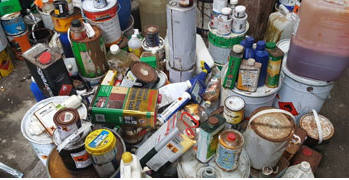Hazardous waste statistics for Ireland
EPA waste data release 31 march 2025. Latest reference year 2023 (data subject to Eurostat validation)
What is hazardous waste?
A waste is hazardous when it can harm human health or the environment because it is explosive, oxidising, flammable, irritant, toxic, carcinogenic, corrosive, infectious, mutagenic, sensitising, or eco-toxic.

Hazardous waste is controlled by strict regulations to protect against the threat to humans and the environment. Examples of hazardous waste types are pictured in Figure 1, and the labels that identify the type of hazard they present are pictured in Figure 2.
The UN Basel Convention came into force in 1992 and its objective is to control transboundary movements of hazardous waste and to protect human health and the environment against the adverse effects resulting from the generation, management, transnational movements and disposal of hazardous and other wastes. EU and Irish Regulations give effect to the Convention in Ireland and strengthen enforcement provisions in relation to waste movements within, into and out of the European Union.
Key Trends

In 2023, Ireland generated a total of 381,764 tonnes of hazardous waste, which is approximately 8,000 tonnes less of hazardous waste generated in 2022. This decrease was largely due to less hazardous soil and stones being accepted by facilities.
Of the total hazardous waste, 189,298 tonnes (approx. 50%) of hazardous waste were treated abroad, while 192,467 tonnes (approx. 50%) were treated in Ireland.
All exports were to countries that are party to the Basel Convention.
Treatment of Hazardous Waste
Hazardous waste is identified with an * in its LOW Code e.g. 15 01 10* hazardous packaging. Hazardous waste generated is the sum of waste from three treatment categories:
Export for treatment
Direct exports take place from
- EPA licensed waste and industrial sites
- LA permitted waste sites.
- Commercial (non-waste) facilities
- Exported directly from sites where it was generated
Treatment on site of generation
- EPA licensed industrial facilities that are licensed to treat the waste generated on their own site.
Treatment in Irish waste facilities
Final treatment takes place at:
- EPA licensed waste facilities
- Pre-treatment from hazardous to non-hazardous waste in Ireland also takes place at EPA licensed facilities
European reporting
As part of annual reporting under the Basel Convention on the control of transboundary movements and the disposal of hazardous waste, the EPA submits hazardous waste statistics for Ireland to the Department of Environment, Climate and Communications for transmission to Eurostat, the statistical office of the European Union. The data are required to be submitted by 31st December of the reference year +1 (i.e. 2023 data were collected and processed in 2024 and submitted to Eurostat by 31st December 2024). Following validation by Eurostat, official statistics for Ireland and all Member States are published on the Eurostat website as part of the following dataset:
- Transboundary shipments of notified waste by partner, hazardousness and waste management operations Transboundary shipments of notified waste by partner, hazardousness and waste management operations (env_wasship)
[1] Edible and food oils are not included
To see data from previous years see: Hazardous Waste Data Archive | Environmental Protection Agency (epa.ie)